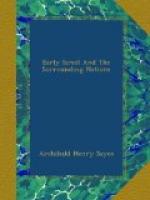The influence of Babylonia, on the other hand, was that of a venerable and a widely reaching culture. The Canaan of the patriarchs and the Canaanitish conquest was a Canaan whose civilisation was derived from the Euphrates, and this civilisation the Israelites themselves inherited. Abraham was a Babylonian, and the Mosaic Law is not Egyptian but Babylonian in character, wherever it ceases to be specifically Israelite. The influence of Babylonia, moreover, continued to the last. It was the Babylonish Exile which changed the whole nature of the Jewish people, which gave it new aims and ideals, and prepared it for the coming of the Messiah. The Babylonian influence which had been working in the West for four thousand years received, as it were, a fresh impulse, and affected the religion and life of Judah in a new and special manner. Nor has the influence of Babylonian culture vanished even yet. Apart from the religious beliefs we have received from Israel, there is much in European civilisation which can be traced back to the old inhabitants of Chaldaea. It came through Canaanitish hands; perhaps, too, through the hands of the Etruscans. At all events, the system of augury which Rome borrowed from Etruria had a Babylonian origin, and the prototype of the strange liver-shaped instrument by means of which the Etruscan soothsayer divined, has been found among the relics of a Babylonian library.
CHAPTER VII
CONCLUSION
Our task is finished. We have passed under review some of the facts which have been won by modern discovery from the monuments of the nations who helped to create the history of Israel. That history no longer stands alone like a solitary peak rising from the plain. Egypt, Babylonia, and Assyria have yielded up their dead; Canaan and even Arabia are now beginning to do likewise. The Oriental world of the past is slowly developing before our eyes; centuries which were deemed pre-historic but a few years ago have now become familiar to us, and we can study the very letters written by the contemporaries and predecessors of Abraham, and read the same books as those that were read by them. A new light has been poured upon the Old Testament; its story has been supplemented and explained; its statements tested and proved.
The Israelites were but one out of many branches of the same family. Their history is entwined around that of their brethren, their characteristics were shared by others of the same race. The Canaan they occupied was itself inhabited by more than one people, and after the first few years of invasion, its influence became strong upon them. In race, indeed, the Jew was by no means pure; at the outset a mixture of Israelite and Edomite, he was further mingled with Moabite and Philistine elements. The first king of Judah as a separate kingdom had an Ammonite mother, and bore an Ammonite name, while the portraits which surmount the names of Shishak’s conquests in southern Palestine show that the old Amorite population was still predominant there. It was religion and history that made the Jew, not purity of race.




